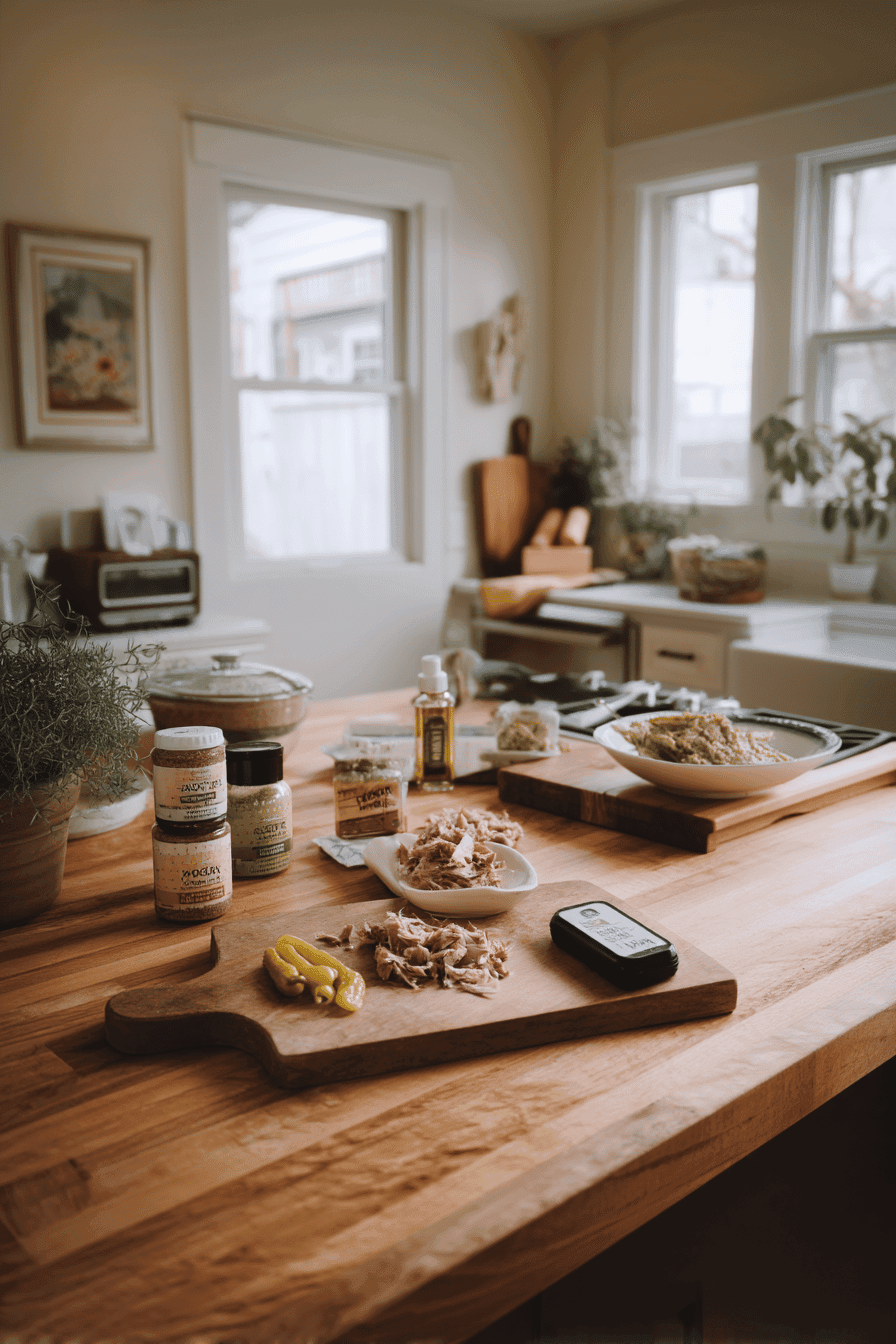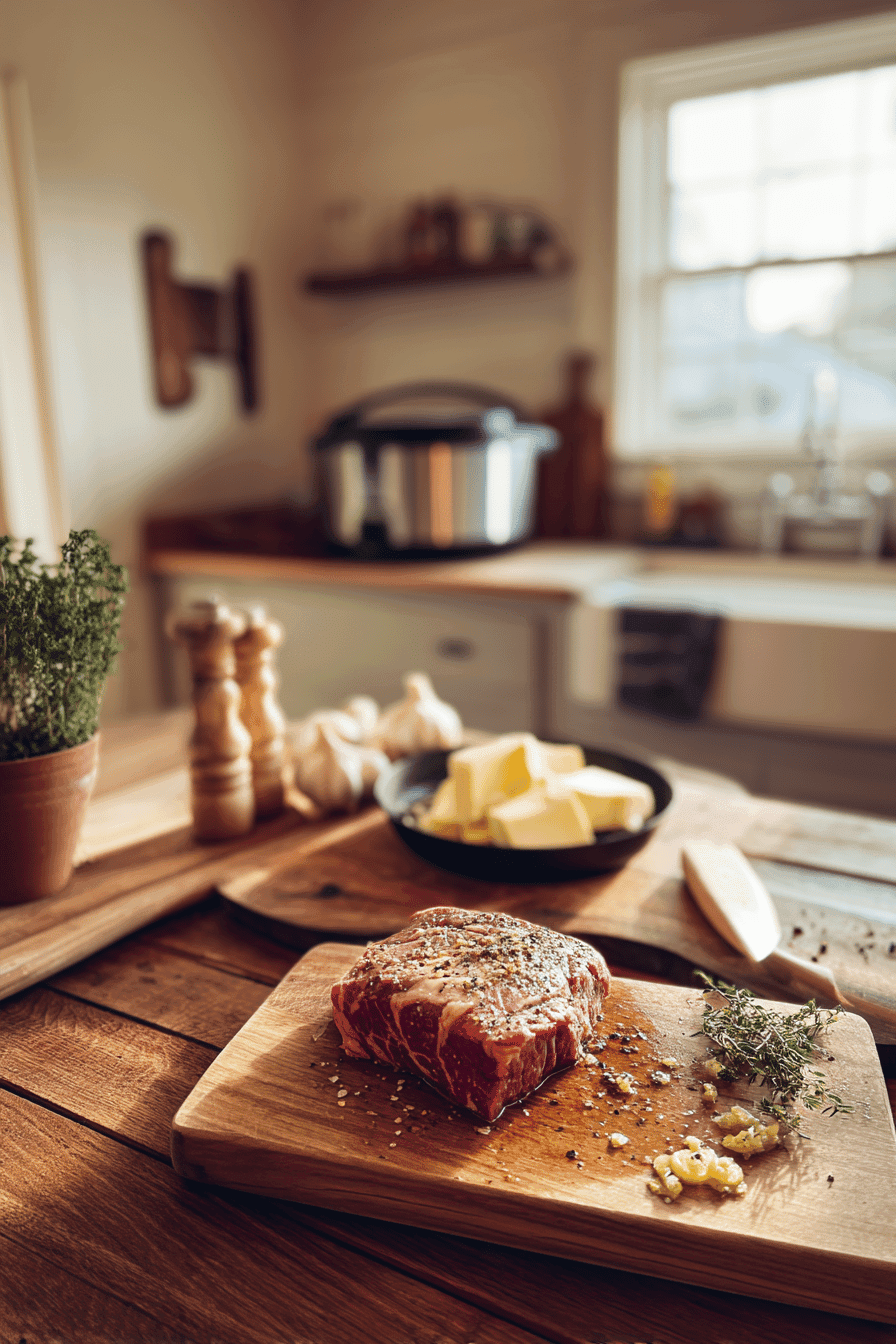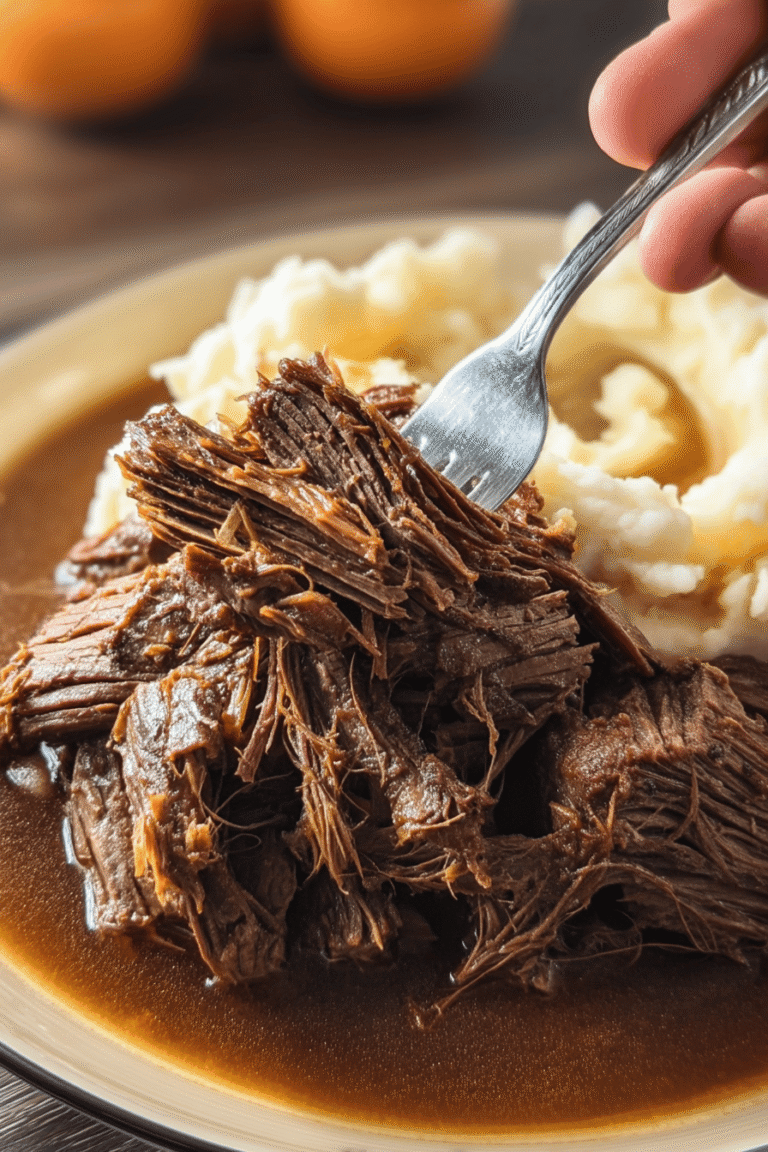Benefits and Advantages of mississippi pot roast
Mississippi pot roast is beloved for its ease of preparation, making it ideal for home cooks of all skill levels. This recipe requires minimal ingredients and hands-on time, yet delivers robust, savory flavors through slow cooking. Health benefits arise as the dish typically uses lean cuts of beef, enriched with spices that add flavor without excessive calories. This recipe stands out due to its unique blend of tangy ranch seasoning, pepperoncini peppers, and butter, which together create a tender, juicy roast bursting with bold flavors. It also lends itself well to adaptations suitable for various dietary needs, making it a versatile and popular meal option.
Jump to:
- Benefits and Advantages of mississippi pot roast
- Essential Ingredients for mississippi pot roast
- Dietary Substitutions to Customize Your mississippi pot roast
- How to Prepare the Perfect mississippi pot roast: Step-by-Step Guide
- Mastering mississippi pot roast: Advanced Tips and Variations
- How to Store mississippi pot roast: Best Practices
- Refrigeration
- Freezing
- Reheating
- Nutritional Value of mississippi pot roast
- FAQs: Frequently Asked Questions About mississippi pot roast
- What ingredients do I need to make Mississippi Pot Roast?
- How long should I cook Mississippi Pot Roast for the best tenderness?
- Can I add vegetables like potatoes and carrots to Mississippi Pot Roast?
- What if I don’t have pepperoncini peppers—can I substitute them?
- How should I store and reheat leftover Mississippi Pot Roast?
- Easy and Flavorful Mississippi Pot Roast Recipe for Tender, Juicy Beef
- Ingredients
- Instructions
- Last Step:
- Notes
- Nutrition
- Did you make this recipe?
Essential Ingredients for mississippi pot roast
The key ingredients for this classic pot roast include:
- 1 (3-5 pounds) chuck roast (for tenderness)
- 1 packet (about 2 tablespoons) ranch dressing mix (adds a distinctive tangy flavor)
- 1 packet (about 1 ounce) au jus gravy mix or dry onion soup mix (enhances savory depth)
- 4 to 8 pepperoncini peppers (provide slight heat and acidity)
- ¼ cup (4 tablespoons) unsalted butter (contributes richness; salted or unsalted both work)
For vegan options, jackfruit can substitute the beef, and vegetable broth-based seasoning blends replace ranch and gravy mixes. Gluten-free alternatives include certified gluten-free seasoning mixes and gluten-free gravy powders. Low-calorie versions can use leaner cuts of meat or plant-based substitutes and reduced amounts of butter or healthier fats, ensuring the recipe remains accessible for diet-conscious individuals while maintaining its delicious essence.

Dietary Substitutions to Customize Your mississippi pot roast
To accommodate various dietary restrictions, several effective substitutions can be employed in making Mississippi pot roast.
- Vegetarian or Vegan: Use shredded jackfruit or seitan in place of the beef roast. Replace ranch and gravy seasoning with vegan and vegetable broth-based blends that mimic the original flavors.
- Gluten-Free: Opt for certified gluten-free ranch seasoning and gravy powder to avoid cross-contamination.
- Dairy-Free: Substitute butter with plant-based oils such as coconut oil or olive oil for richness without dairy.
- Low-Sodium and Reduced-Fat Options: Choose low-sodium seasoning blends and reduce or replace butter with healthier fats to suit heart-healthy or calorie-conscious diets.
These substitutions allow cooks to personalize the recipe while preserving the rich and comforting flavors characteristic of Mississippi pot roast.
How to Prepare the Perfect mississippi pot roast: Step-by-Step Guide
- Season the Roast: Begin by seasoning the beef chuck roast evenly with salt and pepper to enhance its natural flavors. For dietary adaptations, opt for plant-based roasts if preferred.
- Place in Slow Cooker: Put the roast in a slow cooker or crockpot, ensuring there is enough space around it for even cooking.
- Add Seasonings: Sprinkle the ranch seasoning mix and au jus gravy mix evenly over the top of the roast.
- Add Peppers and Butter: Layer pepperoncini peppers on top of the roast, including about ½ cup of their juice for added moisture and flavor. Place pats of unsalted butter over the roast; use plant-based butter or oil for dairy-free versions.
- Cook Slowly: Cover and cook on low for 7-8 hours, or until the meat becomes tender enough to shred easily.
- Shred and Mix: Once fully cooked, shred the roast directly inside the slow cooker to absorb the flavorful cooking juices.
- Serve: Serve over mashed potatoes, rice, or on sandwiches. Customize sides as desired to accommodate dietary preferences.
This straightforward method ensures a tender, flavorful Mississippi pot roast that is simple to prepare and adaptable to many diets.
More details on the recipe can be found at How to Make Mississippi Pot Roast.

Mastering mississippi pot roast: Advanced Tips and Variations
To take your Mississippi pot roast to the next level, begin by marinating the chuck roast overnight in the ranch and au jus seasoning blends to deepen the flavor penetration. A brief sear of the roast on all sides in a hot skillet before slow cooking adds a rich, caramelized crust that enhances texture and taste.
Consider finishing the roast in the oven after slow cooking for 10-15 minutes uncovered to develop a beautifully caramelized exterior. Incorporate sliced onions or minced garlic along with the seasoning for additional savory layers. For a spicier kick, mix in hot sauce or jalapeño slices with the pepperoncini peppers.
For dietary variations, experiment with vegan substitutes such as shredded jackfruit combined with vegan ranch and gravy blends for similar tangy, savory notes. Explore gluten-free seasoning alternatives to preserve safety without sacrificing flavor. Alternative cuts like rump roast or pork shoulder can be used for different textures, keeping in mind longer cooking times may be necessary. Mixing some bacon grease with butter impart a smoky depth of flavor.
These variations and techniques allow you to customize and master your Mississippi pot roast, enjoying tender, richly flavored meat with an appealing crust and balanced seasoning.
For a deep dive on slow cooker versus Instant Pot methods and other cooking tips, see Slow Cooker vs Instant Pot Cooking.
How to Store mississippi pot roast: Best Practices
Proper storage of Mississippi pot roast is essential to maintain its tenderness and flavor for future meals.
Refrigeration
- Let the cooked pot roast cool to room temperature before refrigerating to prevent condensation and sogginess.
- Store leftovers in airtight containers to preserve moisture and block odors.
- Consume refrigerated leftovers within 3-4 days for optimal freshness and food safety.
Freezing
- Freeze portions by wrapping tightly in plastic wrap and placing in freezer-safe bags or containers to prevent freezer burn.
- Frozen roast maintains best quality for up to 3 months.
Reheating
- Thaw frozen portions overnight in the refrigerator to ensure even reheating.
- Reheat gently on stovetop or microwave at medium power to retain moisture and prevent drying.
- Add a splash of beef broth or juices during reheating to enrich flavor and maintain tenderness.
Using these storage practices preserves the dish’s deliciousness and texture, allowing you to enjoy the pot roast beyond the initial serving.
Nutritional Value of mississippi pot roast
Mississippi pot roast delivers a hearty nutritional profile with a good balance of protein, fat, and essential nutrients. Below is an overview of typical nutritional values per serving:
| Nutrient | Amount per Serving |
|---|---|
| Calories | 214–481 kcal |
| Protein | 43–44 g |
| Total Fat | 20–32 g (with ~15 g saturated fat) |
| Carbohydrates | 2–7 g |
| Sodium | 500–1050 mg (varies depending on seasoning) |
| Potassium | ~765–770 mg |
The protein-rich beef supports muscle health, while fats from butter add richness and satiety. Carbohydrate content remains low, fitting well within low-carb diets. Using homemade or low-sodium seasoning mixes can reduce sodium levels for heart-healthy options. Including pepperoncini peppers adds flavor with negligible calories or heat.
Pairing this dish with low-carb sides like cauliflower mash or traditional mashed potatoes completes the meal nutritionally and flavor-wise. For recipe ideas, review Low-Carb Side Dishes for Pot Roast.

FAQs: Frequently Asked Questions About mississippi pot roast
What ingredients do I need to make Mississippi Pot Roast?
How long should I cook Mississippi Pot Roast for the best tenderness?
Can I add vegetables like potatoes and carrots to Mississippi Pot Roast?
What if I don’t have pepperoncini peppers—can I substitute them?
How should I store and reheat leftover Mississippi Pot Roast?

Easy and Flavorful Mississippi Pot Roast Recipe for Tender, Juicy Beef
🥘 This Mississippi Pot Roast is incredibly easy to make, leaving you with mouth-wateringly tender beef!
🍽️ With tons of flavor from simple ingredients, it’s perfect for a stress-free, delicious meal.
- Total Time: 8-10 hours 15 minutes
- Yield: 6–8 servings 1x
Ingredients
1 (3-5 pounds) chuck roast
1 packet (about 2 tablespoons) ranch dressing mix (alternative: homemade seasoning)
1 packet (about 1 ounce) au jus gravy mix or dry onion soup mix (low sodium preferred or homemade version)
4 to 8 pepperoncini peppers (plus about ½ cup of their juice, optional)
¼ cup (4 tablespoons) butter (salted or unsalted; substitute some with bacon grease for smokiness)
Instructions
1. (Optional) Sear the chuck roast in a hot skillet with a little oil for 2-5 minutes per side to enhance flavor.
2. Place the roast in the slow cooker and sprinkle ranch seasoning and au jus mix evenly over it.
3. Layer pepperoncini peppers and butter on top of the roast.
4. Cover and cook on low for 8 to 10 hours, or on high pressure in an Instant Pot for 1 hour with 1 cup of beef broth, followed by natural release.
5. Once cooked and tender, shred the meat and mix with cooking juices.
6. Serve hot, with peppers left whole or chopped into the meat as preferred.
Last Step:
Please leave a rating and comment letting us know how you liked this recipe! This helps our business to thrive and continue providing free, high-quality recipes for you.Notes
🔥 Cooking on low heat without opening the lid ensures juicy, tender meat.
🌶️ Pepperoncini adds flavor and tenderness without making it too spicy.
🌿 Thicken gravy post-cooking with cornstarch and water if desired.
- Prep Time: 5-15 minutes
- Cook Time: 8-10 hours
- Cook Time: 8-10 hours
- Category: Main Course
- Method: Slow Cooking
- Cuisine: American
- Diet: Gluten-Free
Nutrition
- Serving Size: Varies
- Calories: 214-481 kcal
- Sugar: Varies based on seasoning
- Sodium: 500-1050 mg
- Fat: 20-32 g
- Saturated Fat: 15 g
- Carbohydrates: 2-7 g
- Protein: 43-44 g







